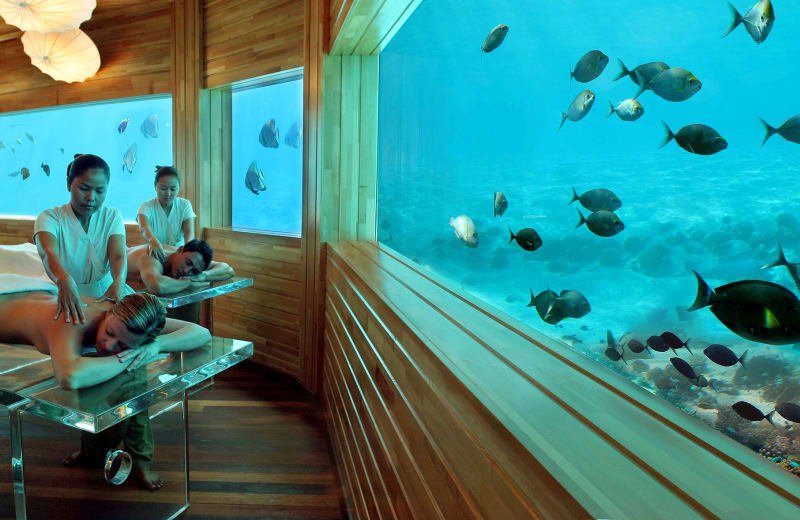Underwater Tourism appeals to almost everyone’s interests and personal inclinations! First, there is what existed in the beginning without human manipulation. Natural attractions are the greatest draw to the sea. Scuba divers, snorkelers, and swimmers come to many destinations just to be in the water and see what Mother Nature has created. To these attractions humans have added their handiwork. Underwater sculpture gardens, artificially-built reefs, and post-offices are a few of these attractions. There is also abundant human history at the bottom of the sea. Shipwrecks, cemeteries, and evidence of the past lie at the bottom of the ocean for those who wish to seek it out. Cities and civilizations have been lost to the waters, and these become their own type of watery ghost town. As technology and human environment building gains speed, plans for the future of travel underwater are drafted. Hotels, undersea restaurants and more are currently proposed. As tourism grows, so too does the rate at which our world is changing. Human and environmental impacts are changing levels of biodiversity, survival rates of reefs, ocean current patterns, and sea levels worldwide. Implications due to these changes for the tourism industry and life on earth are vast. How to heal damages and bring about balance is an immediate and pressing question that needs solutions today. Coral reefs are some of the world’s most incredible underwater attractions. They are the most bio-diverse marine habitat on the planet, displaying sometimes thousands of years of structural growth. It is estimated that 30 million people are completely dependant on reefs for their survival.
Best Underwater Attractions!

MUSA
Underwater Sculpture Museum, Cancun, Mexico
Travel to Cancun, Mexico then take a ferry over to Isla Mujeres. Here you will be able to snorkel, dive or take a glass-bottom boat to view a monumental underwater contemporary museum of art called MUSA (Museo Subacuático de Arte). British sculptor Jason deCaires Taylor created all of these life-sized sculptures with purpose to create an underwater artificial reef. All sculptures are anchored to the seabed and made from specialized materials used to promote coral life and to protect ocean species from predators.

Edivo Underwater Winery
Pelješac, Croatia
This Croatian winery is storing their wines in the Adriatic Sea 18-25 meters below, for 700+ days! For adventurous wine lovers wanting to dive (guided tour), this company offers a unique experience of visiting one of their underwater cellars in Žuljana and Dubrovnik.

Shinkoku Maru Naval Shipwreck
Truk Lagoon, Micronesia
During WWII, Truk Lagoon in Chuuk held the largest number and largest in size of Japanese Naval ships and the area included seaplanes, air strips, repair shops, communication centers and a radar station. During the war, the US saw this area as a vital target to destroy and neutralize a potential threat. The American armada called the mission “Operation Hailstone” and aerial-attacked Truk Lagoon on February 17th and 18th, 1944. Among these ships and planes that were destroyed, were many of the vessels that were used in the attack on Pearl Harbor in 1941. They all now now lie at the bottom of the lagoon as a ghost fleet. This dive site is now a remarkable 500ft long artificial reef that’s covered in beautiful corals and giant schools of various fish. It is a diver’s paradise. Today, divers can easily dive into the engine room and superstructure (bathrooms, infirmary and bridge).

Underwater treatment room at LIME
Photo: Copyright Viva Lifestyle & Travel
Maldives
In the magnificent Maldives, the world’s first underwater spa called LIME is located in the Huvafen Fushi luxury resort. There are two underwater treatment rooms 20 feet below surface. It took one year to complete these rooms in 2010 and they are made of solid-cast resin.

The deceased become part of the living…
Photo: Copyright Neptune Memorial Reef
Neptune Memorial Reef
Key Biscayne, Florida
If you head a little over 3 miles eastbound off the coast of Key Biscayne, FL, you would be able to dive 40 feet below the surface to witness the world’s largest man-made underwater reef mausoleum for cremated remains. The idea was conceived by Gary Levine whose father was Bert Kilbride who died at the age of 93 after spending 40 years of his life searching for sunken treasures in the BVI. Levine wanted a fitting burial site for his father and deemed this sort of burial as appropriate. The design represents the lost city of Atlantis and currently covers less than one acre but will eventually cover 16 acres of barren ocean seafloor to include roads, columns, entrance gates, benches, etc. The first phase of the project will be able to accommodate 850 burials but is projected to eventually have a capacity of 125,000. According to the Neptune Memorial Reef website, the Memorial Reef is a member of the Green Burial Council and is environmentally sound; meeting all of the guidelines and permits required by the EPA, DERM, NOAA, Florida Fish and Wildlife and the Army Corps of Engineers. The slogan of the Memorial Reef is “Creating Life…After Life” which encircles the idea that the structures will promote reef growth. The Department of Environmental Resource Management conducted a study that showed marine life around the reef went from zero to thousands in only two years, proving that the structures are an adequate basis for growth. Divers, students and family members of the deceased can all visit the site without charge. Choosing to have Neptune as a burial site for a loved one not only creates a unique memorial site but also promotes marine life and contributes to an ecological mission. You can choose the shape of seashells, coral or starfish where cremated ashes are mixed with concrete to adhere to the structures in place. Each memorial will have a marked bronze plaque on it as well to identify who is laid to rest there. Families can be a part of the ashes/cement mixing process and can add in little trinkets or sentimental pieces into the mix as well as handprints on the outside of the mold. They can also be apart of the deployment process where you can assist the diver that places the mold on the structure. Supposedly the late Julia Child, the famous television chef, was a part of the Neptune Society and is buried here at the memorial park. Another interesting fact about the burial site is that it is diver-friendly for only about 90 days out of the year due to its unsheltered location. The Memorial Reef was constructed to withstand a stage 5 hurricane current to prevent destruction.

Dine underwater in the Maldives
Photo: Copyright Conrad Hotel & Resorts Maldives
Ithaa Undersea Restaurant
Conrad Maldives Rangali Island
Ithaa, which means mother-of-pearl, is said to be the very first underwater restaurant in the world. It is a part of the Conrad Maldives Rangali Island Resort in Alif Dhaal Atoll in the Republic of Maldives. The undersea restaurant is mainly made of acrylic, 16 feet below the surface of the Indian Ocean, and has a 270 degree panoramic view of the ocean flowing all around. It only seats up to 14 people at one time. A New Zealand designer created Ithaa and it was opened in April of 2005. Rangali Island’s owner is The Crown Company who partnered with the American manufacturer Reynolds Polymer Technology, Inc. to design the tunnel-like restaurant. It was originally built in Singapore and then transported to the Maldives for placement. It is anchored 15 feet into the ocean floor and weighs around 275 tons. Ithaa cost a total of $5 million to build and place. Tripadvisor reviews from former hotel guests were showing that lunch prices ranged approximately $500 per couple for their meal. The restaurant has also been turned into a sleeping suite at one point or another upon special requests and outrageous payment for one evening’s stay. The expected life of Ithaa is only 20 years post-sinking; therefore 2025 will end the undersea dining in the Maldives unless another is built in the meantime.

Mail a postcard underwater at Mile Island
Photo: Copyright Smithsonian Magazine
Vanuatu Post Office
Mele Island, South Pacific
Vanuatu Island is in the South Pacific Ocean situated northeast of New Caledonia, west of Fiji, and southeast of the Solomon Islands. Mele Island (known as Hideaway Island to visitors) is famous for having one of few underwater post offices in the world. Created in 2003, it is 3 meters deep and is within the Hideaway Island Marine Sanctuary. Here, you can actually mail a waterproof postcard to any place in the world. The postcards are collected regularly by one of Vanuatu Post’s four trained scuba divers and “cancelled” underwater with an embossing cachet. The post office has received around 200,000 visitors since it’s opening.

Go diving for Pirate’s gold in the Keys!
Photo: Copyright Florida Keys National Marine Sanctuary
Florida Keys Shipwreck Trails
Florida Keys, Florida
A 126-mile stretch of ocean between Key Largo and Key West, FL, contains almost 500 historical shipwrecks and the only living coral reef in the Continental United States. These shipwrecks include 1700’s Spanish explorer vessels, modern cargo and military ships as well as purposely-sunken ships to promote artificial reef building. Among these is the famous La Capitana wreck, from Spain’s 1733 Armada, which was discovered in the late 1930s by Art McKee. Among the many shipwrecks, gold, silver bars, coins, emeralds, jewelry and historic artifacts have been discovered and placed in museums throughout The Keys. According to the Florida Maritime Heritage Trail website, war, piracy, hurricanes, and treacherous shoals have all contributed to the loss of several thousand vessels in Florida waters. The Florida Keys National Marine Sanctuary Shipwreck Trail contains fifteen ships, five of them are within 25 feet of water or less which makes them easy to see from above as well as for intermediate divers and snorkelers. Of course, one of the largest issues with diving tourism in these areas is contributed to thieves taking artifacts from wreckage and from the seaboard. These artifacts could potentially help historians piece together unknown information about some of the wrecks that are in The Keys and answer mysteries behind some of these events. Chests of gold coins and silver are still being found buried at sea or on shorelines of Florida’s coasts. Many people spend years in search for treasures and lost ships that are known to have sunk off the coasts of the Florida Keys.

Lion City lies at the bottom of a lake
Photo: Copyright BBC Travel
Lion City
Quiandao Lake, China
Rediscovered in 2001, 100 feet beneath Thousand Island Lake, lies the ruins of Lion City. This incredible city hails from the Eastern Han dynasty (25-200 CE) and was flooded by a 1950’s government dam project. Lion City boasts incredible relief sculptures, 265 intact arches and 62 football fields of submerged city to explore. Since its rediscovery, the city has become an important international tourist destination. Plans for the future of this city may make this an even more unique and incredible journey, including transparent floating tunnels for easier access.
Source: https://www.anomilee.com/new-page-2









0 Comments